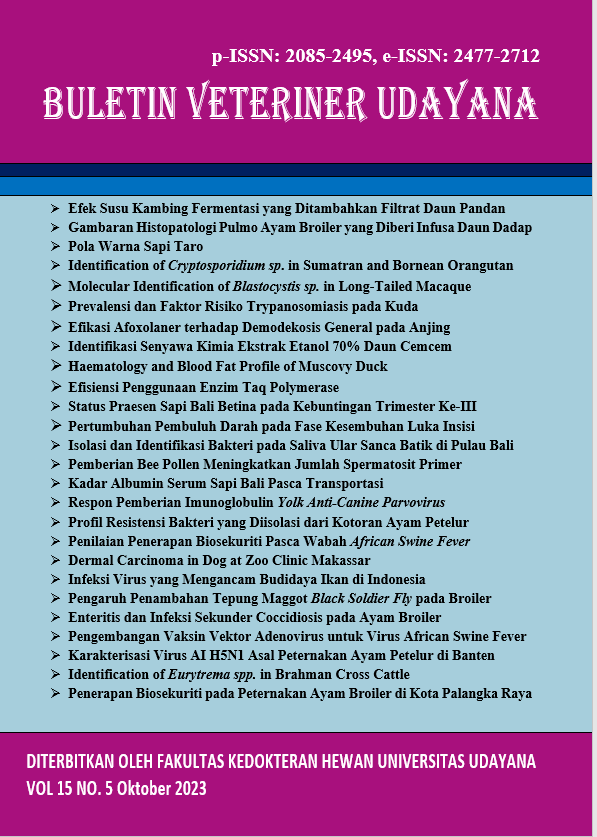CHARACTERISTIC OF INFLUENZA VIRUS H5N1 FROM LAYER POULTRY FARM LEGOK DEMARCATION, SERANG DISTRICK, BANTEN
Abstract
Avian Influenza virus infection is still a serious concern in the poultry sector in Indonesia. The molecular character of the AI virus that easily mutates is thought to be a factor in the AI virus continuing to spread and having endemic status. This study aims to characterize the Avian Influenza virus from laying poultry in Legok District, Serang Districk, Banten as a form of preparation for the AI H5N1 vaccine. The test sample used is a collection of isolates owned by PT. Sanbio Laboratories, Bogor with the name Legok isolate. This study used two comparator isolates, namely Sukoharjo isolate (A/Duck/Sukoharjo/BBVW-1428/2012) and Garut isolate (A/Chicken/Garut/BBVW-223/2007) which are the master seeds of the local AI H5N1 vaccine. Virus isolation was carried out on embryonated chicken eggs (TAB) aged 9 days and then the virus isolation results were tested using the fast and slow hemagglutination (HA) test to detect the presence of the virus, the Reverse Transcritase Polymerase Chain Reaction (RT-PCR) test was used to see AI virus subtypes and then confirmed by sequencing tests to see the genetic distance and kinship between the isolates tested. The result is that Legok isolate is in the same clade as Sukoharjo isolate, which is in clade 2.3.2, but Legok isolate forms a new subclade 2.3.2 variant, while Garut isolate is in clade 2.1.3. The genetic distance for each isolate obtained was that Legok isolate to Sukoharjo isolate had a genetic difference of 3%, homology 97%, Legok isolate to Garut isolate had a genetic difference of 11.5%, 88.5% homology while Sukoharjo isolate to Garut isolate the genetic difference is 9% and the homology is 91%. The conclusion is that the Legok isolate has different characteristics from the Sukoharjo isolate and the Garut isolate. This indicates that the Legok isolate has a mutation, so it is necessary to carry out monitoring and further research for vaccine seeds from Legok isolate.
Downloads
References
Guan Y, Smith GJ, Webby R, Webser RG. 2009. Moleculer epidemiology of H5N1. Rev. Sci. Tech. 28(1): 29-47.
Dharmayanti NLPI. 2011. Metode taksonomi organisme berdasarkan sejarah evolusi. filogenetika molekula: metode taksonomi organisme berdasarkan sejarah evolusi. Wartazoa. 21(1): 1–10.
Dharmayanti NLPI, Thor SW, Zanders N, Hartawan R, Ratnawati A, Jang Y, Rodriguez M, Suarez DL, Samaan G, Pudjiatmoko, Davis C.T. 2018. Attenuation of highly pathogenic avian influenza A (H5N1) viruses in Indonesia following the reassortment and acquisition of genes from low pathogenicity avian influenza A virus progenitors. Emerg. Microb. Infect. 7(1): 1–14.
Hewajuli DA, Dharmayanti NLPI. 2008. Karakterisasi Dan Identifikasi Virus Avian Influenza (AI). Wartazoa. 18(2): 86–100.
Kencana GAY, Mahardika IGNK, Suardana IBK, Asnawan MIN, Krisna DNM, Narendra PGN. 2012. Pelacakan kasus flu burung pada ayam dengan reverse trancriptase polymerase chain. J. Vet. 13(3): 303-308.
Kencana GAY, Suartha IN, Nurhandayani A, Ramadhan M. 2014. Kepekaan telur spesific pathogen free dan clean egg terhadap virus flu burung. J. Vet. 15(1): 87–93.
Kencana GAY, Suartha N, Simbolon MP, Handayani AN, Ong S, Syamsidar, Kusumastuti A. 2015. Respon antibodi terhadap penyakit tetelo pada ayam yang divaksin tetelo dan tetelo-flu burung. J. Vet. 16(2): 283-290.
Kencana GAY, Suartha IN, Kardena IM, Nurhandayani A. 2020. Karakterisasi virus avian influenza subtipe H5N1 isolat lapang asal Bali untuk kandidat vaksin. J. Vet. 21 (4): 530-538
Kencana GAY, Suartha IN, Kardena IM, Agustina KK. 2021. Seroprevalence and Detection of H5N1 avian influenza virus in local chickens in Tabanan regency, Bali, Indonesia. Acta Vet. Indon. 9(3): 223-229.
Mahardika IGNK, Suartha IN, Suardana IB, Kencana IGAY, Wibawan IWT. 2009. Perbandingan sekuens consensus gen hemaglutinin virus avian influenza subtipe H5N1 asal unggas Indonesia dengan subtipe H5N2 dan H5N9. J. Vet. 10(1): 12-16.
Mahardika IGNK, Astawa INM, Kencana GAY, Suardana IBK, Sari, TK. 2016. Teknik Lab Virus. Udayana University Press. Denpasar.
Musdalifa A, Kencana GAY, Suartha IN. 2020. Deteksi antigen virus avian influenza pada ayam kampung di pasar hewan Beringkit dan pasar umum Galiran, Bali. Indon. Med. Vet. 9(5): 757-772.
Setiarto RHB. 2020. Mengenal virus flu burung H5N1 (Avian Influenza), pencegahan dan pengobatannya. Guepedia. Bogor
Stevenes J, Blixt O, Tumpey TM, Taunberger JK, Paulson JC, Wilson IA. 2006. Structure and receptore specificity of hemagglutinin from an H5N1 influenza virus. Sci. 312: 4-10.
Suarez DL. 2008. Avian Influenza dalam Avian Influenza, Blackwell Publishing Blackwell Publishing Professional 2121 State Avenue, Ames, Iowa 50014, USA. Pp. 3-22.
OIE. 2004. Manual of Diagnostic Test and Vaccines for Terrestrial Animal. World Organitation for Animals Health 4: 258-269.
OIE. 2009. Office International des Epizooties (OIE). Terrestial Manual: Chapter 2.3.4. Avoian Influenza. http://www.oie.int/Health_Standars/tahm/2.03.04_AI.pdf.
Wibawa H, Dharmawan R, Mulyawan H, Mahawan T. 2018. Deteksi dan identifikasi virus-virus reassortant highly pathogenic avian influenza H5N1 clade 2.3.2.1c dengan teknik next generation sequencing. Bul. Lab. Vet. 18(1): 1–13.
WHO. 2006. H5N1 Avian Influenza: Timeline, 1547. February 2006. www.who.int.





